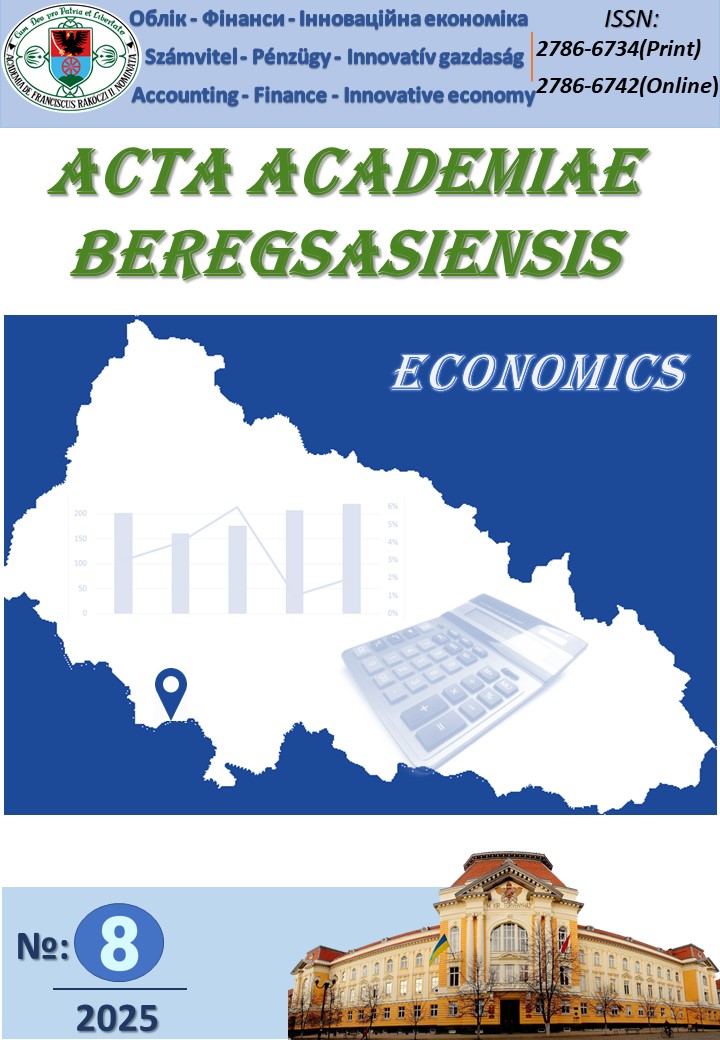Assessment of Vulnerabilities in the Real Sector of European Economies
DOI:
https://doi.org/10.58423/2786-6742/2025-8-240-253Keywords:
economic vulnerability, European countries, real sector, entropy weighted methodAbstract
The assessment of economic vulnerability is a key tool for analyzing the stability and resilience of the real sector of national economies, particularly in the context of global economic transformations and external shocks. This article proposes an approach to evaluating the economic vulnerability of the real sector in European countries, taking into account factors such as industrial development, macroeconomic indicators, and employment levels. A comprehensive methodology is introduced, combining the Entropy Weight Method (EWM) to determine indicator significance with a sensitivity and adaptability framework for measuring economic vulnerability. The study analyzes major macroeconomic indicators, including GDP growth rates, inflation, unemployment, and savings levels. Structural vulnerability of the real sector is assessed using statistical data from 2000 to 2023, and a Real Sector Vulnerability Index is developed based on data from the World Bank’s economic development indicators. The findings reveal significant regional disparities: countries in Northern and Western Europe exhibit lower levels of vulnerability due to balanced industrial structures and effective economic policies, while countries in Eastern and Southern Europe display greater sensitivity to economic shocks, reflecting structural imbalances. The methodology is based on econometric modeling tools and utilizes Python-based data analysis packages to explore dynamic relationships between macroeconomic variables over time. The results indicate that countries with diversified economic bases tend to demonstrate higher resilience, whereas economies with limited industrial diversification remain more susceptible to external risks. The proposed approach enhances the methodological foundation for evaluating economic vulnerability and provides a basis for informed policy decisions aimed at strengthening the resilience of the real sector under conditions of economic instability. The insights gained are of critical importance for policymakers in identifying and mitigating risk factors, thereby contributing to sustainable economic development across European regions.
References
Briguglio, L., Cordina, G., Farrugia, N., & Vella, S. (2009). Economic vulnerability and resilience: Concepts and measurements. Oxford Development Studies, 37(3), 229–247. https://doi.org/10.1080/13600810903089893 DOI: https://doi.org/10.1080/13600810903089893
Cordina, G. (2007). Economic resilience and market efficiency in small states. Occasional Papers on Islands and Small States, 1, 1-14.
Cariolle, J., Goujon, M., & Guillaumont, P. (2015). Has structural economic vulnerability decreased in least developed countries? Lessons drawn from retrospective indices. The Journal of Development Studies, 52(5), 591–606. https://doi.org/10.1080/00220388.2015.1098631 DOI: https://doi.org/10.1080/00220388.2015.1098631
Guillaumont, P. (2009). An economic vulnerability index: Its design and use for international development policy. Oxford Development Studies, 37(3), 193–228. https://doi.org/10.1080/13600810903089901 DOI: https://doi.org/10.1080/13600810903089901
Béné, C. (2009). Are fishers poor or vulnerable? Assessing economic vulnerability in small-scale fishing communities. The Journal of Development Studies, 45(6), 911–933. https://doi.org/10.1080/00220380902807395 DOI: https://doi.org/10.1080/00220380902807395
Whelan, C. T., & Maître, B. (2014). The Great Recession and the changing distribution of economic vulnerability by social class: The Irish case. Journal of European Social Policy, 24(5), 470–485. https://doi.org/10.1177/0958928714545444 DOI: https://doi.org/10.1177/0958928714545444
Wang, C. (2013). Reconsidering the economic vulnerability index of the United Nations. Canadian Journal of Development Studies/Revue canadienne d'études du développement, 34(4), 553–568. https://doi.org/10.1080/02255189.2013.814566 DOI: https://doi.org/10.1080/02255189.2013.814566
Altimari, A., Balzano, S., & Zezza, G. (2019). Measuring economic vulnerability: A structural equation modeling approach. У Statistical learning of complex data (с. 95–102). Springer International Publishing. https://doi.org/10.1007/978-3-030-21140-0_10 DOI: https://doi.org/10.1007/978-3-030-21140-0_10
Blancard, S., Bonnet, M., & Hoarau, J.-F. (2020). The influence of agriculture on the structural economic vulnerability of small island spaces: Assessment using DEA based composite indicators. Applied Economics, 53(1), 79–97. https://doi.org/10.1080/00036846.2020.1795071 DOI: https://doi.org/10.1080/00036846.2020.1795071
Meinen, P., Serafini, R., & Papagalli, O. (2021). Regional economic impact of covid-19: the role of sectoral structure and trade linkages. SSRN Electronic Journal. https://doi.org/10.2139/ssrn.3797148 DOI: https://doi.org/10.2139/ssrn.3797148
Akter, S. and Grafton, R. Q. (2021). Do fires discriminate? socio-economic disadvantage, wildfire hazard exposure and the australian 2019–20 ‘black summer’ fires. Climatic Change, 165(3-4). https://doi.org/10.1007/s10584-021-03064-6 DOI: https://doi.org/10.1007/s10584-021-03064-6
Ünlü, D., Yurtsever, E., Artan, T., & Irmak, H. S. (2022). An examination of conditions exposing older adults to economic abuse: logistic regression analysis. Journal of Applied Gerontology, 41(12), 2480-2489. https://doi.org/10.1177/07334648221116159 DOI: https://doi.org/10.1177/07334648221116159
Liu, B. (2022). Research on the economic resilience of chinese cities and analysis of its influencing factors - based on the perspective of china’s three major urban agglomerations. Academic Journal of Business &Amp; Management, 4(18). https://doi.org/10.25236/ajbm.2022.041803 DOI: https://doi.org/10.25236/AJBM.2022.041803
Gnangnon, S. K. (2023). Export product concentration and poverty volatility in developing countries. The International Trade Journal, 1–24. https://doi.org/10.1080/08853908.2023.2192016 DOI: https://doi.org/10.1080/08853908.2023.2192016
Bussière, M., & Mulder, C. (1999). Political instability and economic vulnerability. SSRN Electronic Journal. https://doi.org/10.2139/ssrn.727423 DOI: https://doi.org/10.2139/ssrn.727423
Briguglio, L. P. (2016). Exposure to external shocks and economic resilience of countries: Evidence from global indicators. Journal of Economic Studies, 43(6), 1057–1078. https://doi.org/10.1108/jes-12-2014-0203 DOI: https://doi.org/10.1108/JES-12-2014-0203
World development indicators (2024) DataBank | The World Bank. https://databank.worldbank.org/source/world-development-indicators (last accessed: 06.11.2024)
Downloads
Published
Issue
Section
License
Copyright (c) 2025 Vadym Pakholchuk

This work is licensed under a Creative Commons Attribution-NonCommercial 4.0 International License.
Authors retain copyright and grant the journal right of first publication with the work simultaneously licensed under a Creative Commons CC BY-NC License.


